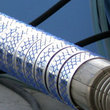|
|
|
 |
More than 15 years experience in laser welding technology • machine manufacture for perfect automation of welding • automatic clamping systems • complete automation of pipe manufacture from coil up to final product. |
| Employees : |
230 |
| Year established : |
1926 |
Business : |
Manufacturer |
 Flexible tube manufacturing Flexible tube manufacturing
A flexible new production method now allows thin-walled tubes, which are further processed into heavy-duty hydroformed compensators, to be manufactured very economically in small lot sizes. With this compact production system, component exchanges and costly retooling time belong to the past.
A flexible new production method now allows thin-walled tubes, which are further processed into heavy-duty hydroformed compensators, to be manufactured very economically in small lot sizes. With this compact production system, component exchanges and costly retooling time belong to the past.
In the production of metal tube compensators - so-called flexitubes - manufacturing flexibility is increasingly in demand to allow economical production of small lot sizes. A paramount objective must be minimizing the expenditures for exchange components as well as the time required for retooling the systems. The existing level of automation and high system availability, however, should not be affected in any way.
Industrial users are demanding more and more often tubes with diameters from 60 mm to 150 mm and sheet metal thicknesses from 0.2 mm to 0.4 mm. Such are impossible, or at best very difficult, to manufacture on today's production facilities. Against this backdrop, a new production method has been developed that takes these criteria as well as user requirements into account.
Previous method requires large quantities
As is well known, the current production of thin-walled (thickness between 0.15 mm and 0.4 mm) stainless steel (material number 1.4301) flexitubes in the diameter range from 40 mm to 80 or 120 mm and length range from 200 to 2000 mm on continuous tube production lines has to be carried out with very large quantities. In the case of 2-ply or even 3-ply tube products, each diameter requires its own continuous tube production line. Other diameters or smaller lot sizes are uneconomical due to the time and expensive tool changes required for conversion.
The production steps required in a continuous system are extremely wide-ranging and complex. The many processes that build upon each other to join together inner tube and outer tube and the subsequent reshaping into a flexitube allow economic production only in large quantities. Moreover, the coil width must correspond exactly with the tube circumference, which determines the diameter.
The individual successive processes are:
• Step 1: Coil trimming - approx. 2 mm per side.
• Step 2: Forming the sheet metal band into a slitted tube.
• Step 3: Welding the tube with a plasma or laser source.
• Step 4: Cutting the endless tube to the required lengths with flying shears.
• Step5 5: Forming and calibrating the two tube ends to compensate for damage caused during cutting.
• Step 6: Sliding inner tube into outer tube (2-ply flexitube).
• Step 7: Forming the manufactured straight tube into a corrugated tube.
With 2-ply tubes, steps 1 to 5 are required for both the inner tube and the outer tube.
Flexible production from metal blanks
Unlike production in a continuous system, where inner and outer tubes are created from the coil, flexible short tube production starts with considerably more manageable sheet metal blanks. The required production steps are reduced to the following individual processes:
• Step 1: Cut blank to size.
• Step 2: Rounding station: round blank 1 + 2 (alternatingly - rounding machine adjusts itself automatically).
• Step 3: Welding station: weld inner tube - weld outer tube (alternatingly - welding machine adjusts itself automatically).
• Step 4: Slide inner tube into outer tube.
• Step 5: Form the manufactured straight tube into a corrugated tube.
Compared with conventional tube production in continuous systems, the new method of flexible short tube production features a whole number of economic and technological advantages. Here, a summary of the most important ones:
• Flexible tube manufacturing system for the entire working range from 50 to 150 mm diameter and lengths up to 2000 mm (no component exchanges - no time required for conversion).
• No expenditures for exchange components; entire working range is covered by one set of tools.
• No tube cutting required, i.e. no edges are damaged by the difficult cutting process (e.g. Ø120 x 0.2 mm high-grade steel 1.4301).
• Diameter/sheet thickness ratio 400 mm/0.8 mm is possible.
Flexible production cell for thin-walled quality tubes
A newly developed flexible production cell for the fabrication of thin-walled quality tubes outputs tubes of different diameters in a 20-second cycle, completely program-controlled and with a clamping concept that allows switching between any number of different diameters.
Proven concepts, like the multi-roller round bending machine, were combined with a newly developed tube guidance system to create a completely automatic system. Occupying very little floor space, this operation-friendly, compact tube production plant can manufacture different diameters alternatingly without any loss of productivity.
This automation solution includes a stacker and pallet exchanger on the feed side as well as automated withdrawal after the welding station. Expanding, crimping and marking stations are extendable. The innovative rounding and clamping concept allows different diameters to be produced completely without component exchanges as well as different diameters alternatingly (e.g. inner tube - outer tube).
Within the machine the rounded tube is welded automatically on the fly and ejected into the placement area. The machine achieves maximum production output with a laser welding source.
The choice of welding source, whether laser, WIG or plasma, is oriented toward customer requirements. If necessary, the laser welding source can be retrofitted any time.
The mobile brush basket ensures that the surfaces of the metal parts do not get damaged. Due to the sophisticated clamping concept, only very small clamping forces act on the part during round bending. The finished stainless steel tubes can thus be further processed immediately.
The greatest cost saving lies in the alternating production of mid-sized and large lots as well as the rounding and welding without cycle time losses and without additional tool costs.
The system gets by entirely without component exchanges, whether for diameter changes, length modifications or short-term quantity changes – all adjustments are program controlled.
We provide sustainable inspiration to our customers by working with them in realizing fascinating and valuable solutions in the field of sheet metal processing.
Realizing fascinating solutions
We empower our customers to fully leverage their potential in the production of sheet metal and metal assemblies in order to achieve economic goals and sustainable success. Our manufacturing solutions are deployed wherever change takes place and tomorrow’s products are created.
We have been developing machines and modular systems for 35 years, which are characterized by the combination of innovative laser, clamping and automation technologies and enable versatile production steps in the processes forming, cutting and joining.
Our solutions and services are characterized by expertise, flexibility and commitment. Our central goal is to provide added value for our customers and to satisfy their needs, as has been demonstrated by thousands of installations worldwide and our many long-term partnerships. 
| Roll forming machines | 
| Tube finishing machines | 
| Tube production centers | |
|
|

